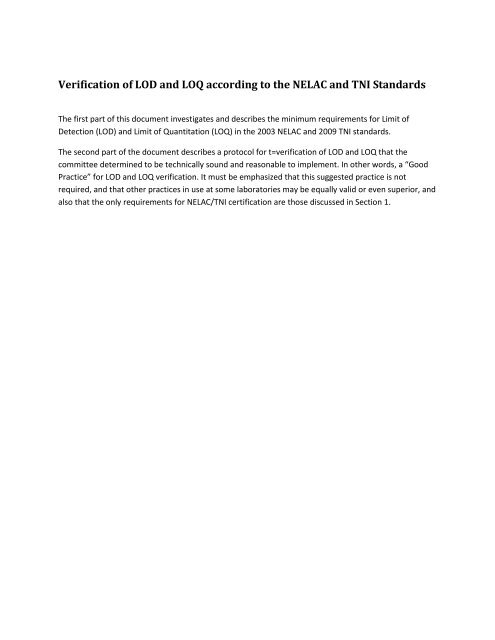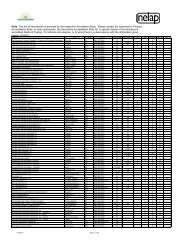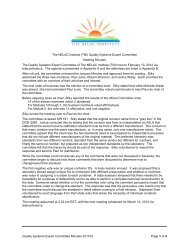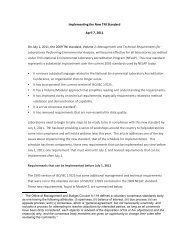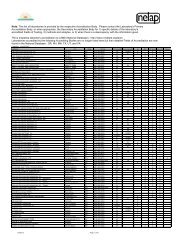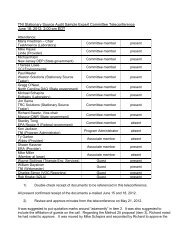Verification of LOD and LOQ according to the NELAC and TNI ...
Verification of LOD and LOQ according to the NELAC and TNI ...
Verification of LOD and LOQ according to the NELAC and TNI ...
You also want an ePaper? Increase the reach of your titles
YUMPU automatically turns print PDFs into web optimized ePapers that Google loves.
<strong>Verification</strong> <strong>of</strong> <strong>LOD</strong> <strong>and</strong> <strong>LOQ</strong> <strong>according</strong> <strong>to</strong> <strong>the</strong> <strong>NELAC</strong> <strong>and</strong> <strong>TNI</strong> St<strong>and</strong>ards<br />
The first part <strong>of</strong> this document investigates <strong>and</strong> describes <strong>the</strong> minimum requirements for Limit <strong>of</strong><br />
Detection (<strong>LOD</strong>) <strong>and</strong> Limit <strong>of</strong> Quantitation (<strong>LOQ</strong>) in <strong>the</strong> 2003 <strong>NELAC</strong> <strong>and</strong> 2009 <strong>TNI</strong> st<strong>and</strong>ards.<br />
The second part <strong>of</strong> <strong>the</strong> document describes a pro<strong>to</strong>col for t=verification <strong>of</strong> <strong>LOD</strong> <strong>and</strong> <strong>LOQ</strong> that <strong>the</strong><br />
committee determined <strong>to</strong> be technically sound <strong>and</strong> reasonable <strong>to</strong> implement. In o<strong>the</strong>r words, a “Good<br />
Practice” for <strong>LOD</strong> <strong>and</strong> <strong>LOQ</strong> verification. It must be emphasized that this suggested practice is not<br />
required, <strong>and</strong> that o<strong>the</strong>r practices in use at some labora<strong>to</strong>ries may be equally valid or even superior, <strong>and</strong><br />
also that <strong>the</strong> only requirements for <strong>NELAC</strong>/<strong>TNI</strong> certification are those discussed in Section 1.
Section 1 – Requirements for <strong>Verification</strong> <strong>of</strong> <strong>LOD</strong> <strong>and</strong> <strong>LOQ</strong><br />
When is a <strong>LOD</strong> required?<br />
2003 <strong>NELAC</strong> st<strong>and</strong>ard 2009 <strong>TNI</strong> st<strong>and</strong>ard<br />
An <strong>LOD</strong> is not required for a test method when<br />
test results are not reported outside <strong>of</strong> <strong>the</strong><br />
calibration range<br />
1.5.2.1 If <strong>the</strong> labora<strong>to</strong>ry is not reporting a value<br />
below <strong>the</strong> Limit <strong>of</strong> Quantitation, a Limit <strong>of</strong><br />
Detection Study is not required<br />
The <strong>TNI</strong> st<strong>and</strong>ard also requires that <strong>the</strong> lowest calibration st<strong>and</strong>ard be at or below <strong>the</strong> <strong>LOQ</strong>. Therefore<br />
<strong>the</strong> <strong>NELAC</strong> <strong>and</strong> <strong>TNI</strong> requirements are equivalent – <strong>LOD</strong> determination <strong>and</strong> verification is required if<br />
results are reported below <strong>the</strong> lowest calibration st<strong>and</strong>ard, o<strong>the</strong>rwise <strong>the</strong>re is no requirement for a <strong>LOD</strong><br />
study.<br />
2003 <strong>NELAC</strong> st<strong>and</strong>ard 2009 <strong>TNI</strong> st<strong>and</strong>ard<br />
The labora<strong>to</strong>ry shall determine <strong>the</strong> <strong>LOD</strong> for <strong>the</strong><br />
method for each target analyte <strong>of</strong> concern in <strong>the</strong><br />
quality system matrices. All sample processing<br />
steps <strong>of</strong> <strong>the</strong> analytical method shall be included in<br />
<strong>the</strong> determination <strong>of</strong> <strong>the</strong> <strong>LOD</strong><br />
All sample-processing <strong>and</strong> analysis steps <strong>of</strong> <strong>the</strong><br />
analytical method shall be included in <strong>the</strong><br />
determination or validation <strong>of</strong> <strong>the</strong> <strong>LOD</strong>.<br />
When required, <strong>the</strong> labora<strong>to</strong>ry shall determine or<br />
verify <strong>the</strong> <strong>LOD</strong> for <strong>the</strong> method for each target<br />
analyte <strong>of</strong> concern in <strong>the</strong> quality system matrices.<br />
If <strong>the</strong> lab is reporting below <strong>the</strong> <strong>LOQ</strong>, <strong>the</strong>n <strong>the</strong> <strong>LOD</strong> determination is required for each analyte <strong>and</strong> for<br />
each <strong>of</strong> <strong>the</strong> quality system matrices. The statement that all steps in <strong>the</strong> method must be included<br />
implies that separate <strong>LOD</strong> determinations are required for different preparation techniques. For<br />
example <strong>the</strong> combination <strong>of</strong> Method 3510 (Separa<strong>to</strong>ry funnel extraction) with method 8270 (GC/MS)<br />
would require a separate <strong>LOD</strong> determination from <strong>the</strong> combination <strong>of</strong> method 3520 (Continuous liquidliquid<br />
extraction) with method 8270.<br />
2003 <strong>NELAC</strong> st<strong>and</strong>ard 2009 <strong>TNI</strong> st<strong>and</strong>ard<br />
An <strong>LOD</strong> study is not required for any component or<br />
property for which spiking solutions or quality<br />
control samples are not commercially available, or<br />
o<strong>the</strong>rwise inappropriate (e.g., pH)<br />
O<strong>the</strong>r examples <strong>of</strong> methods where <strong>LOD</strong> determinations are not required are<br />
Need list <strong>of</strong> example methods<br />
An <strong>LOD</strong> study is not required for any component<br />
for which spiking solutions or quality control<br />
samples are not available, such as temperature
How should a <strong>LOD</strong> be determined?<br />
2003 <strong>NELAC</strong> st<strong>and</strong>ard 2009 <strong>TNI</strong> st<strong>and</strong>ard<br />
All sample processing steps <strong>of</strong> <strong>the</strong> analytical<br />
method shall be included in <strong>the</strong> determination <strong>of</strong><br />
<strong>the</strong> <strong>LOD</strong><br />
<strong>LOD</strong>s shall be determined by <strong>the</strong> pro<strong>to</strong>col in <strong>the</strong><br />
m<strong>and</strong>ated test method or applicable regulation. If<br />
<strong>the</strong> pro<strong>to</strong>col for determining <strong>LOD</strong>s is not specified,<br />
<strong>the</strong> selection <strong>of</strong> <strong>the</strong> procedure must reflect<br />
instrument limitations <strong>and</strong> <strong>the</strong> intended<br />
application <strong>of</strong> <strong>the</strong> test method.<br />
All sample-processing <strong>and</strong> analysis steps <strong>of</strong> <strong>the</strong><br />
analytical method shall be included in <strong>the</strong><br />
determination or validation <strong>of</strong> <strong>the</strong> <strong>LOD</strong>.<br />
If a m<strong>and</strong>ated test method or applicable regulation<br />
includes pro<strong>to</strong>cols for determining detection<br />
limits, <strong>the</strong>se shall be followed. The labora<strong>to</strong>ry shall<br />
document how <strong>LOD</strong>s were derived from <strong>the</strong><br />
determinations. If <strong>the</strong> pro<strong>to</strong>col for determining <strong>the</strong><br />
<strong>LOD</strong> is not specified, <strong>the</strong> selection <strong>of</strong> <strong>the</strong><br />
procedure shall reflect instrument limitations <strong>and</strong><br />
<strong>the</strong> intended application <strong>of</strong> <strong>the</strong> test method.<br />
The language in <strong>the</strong> two st<strong>and</strong>ards is essentially equivalent. Both are clear that all steps <strong>of</strong> <strong>the</strong> method<br />
must be included in <strong>the</strong> development <strong>of</strong> <strong>the</strong> <strong>LOD</strong>, <strong>and</strong> both are very open regarding <strong>the</strong> method <strong>to</strong> be<br />
used <strong>to</strong> determine <strong>LOD</strong>.
How may a <strong>LOD</strong> be verified?<br />
2003 <strong>NELAC</strong> st<strong>and</strong>ard 2009 <strong>TNI</strong> st<strong>and</strong>ard<br />
The validity <strong>of</strong> <strong>the</strong> <strong>LOD</strong> shall be confirmed by<br />
qualitative identification <strong>of</strong> <strong>the</strong> analytes in a QC<br />
sample in each quality system matrix containing<br />
<strong>the</strong> analyte at no more than 2-3X <strong>the</strong> <strong>LOD</strong> for<br />
single analyte tests <strong>and</strong> 1-4X <strong>the</strong> <strong>LOD</strong> for multiple<br />
analyte tests. This verification must be performed<br />
on every instrument that is <strong>to</strong> be used for <strong>the</strong><br />
analysis <strong>and</strong> reporting <strong>of</strong> data.<br />
The validity <strong>of</strong> <strong>the</strong> <strong>LOD</strong> shall be verified by<br />
detection (a value above zero) <strong>of</strong> <strong>the</strong> analyte(S) in<br />
a QC sample in each quality system matrix. This QC<br />
sample shall contain <strong>the</strong> analyte at no more than<br />
3X <strong>the</strong> <strong>LOD</strong> for single analyte tests <strong>and</strong> 4X <strong>the</strong> <strong>LOD</strong><br />
for multiple analyte tests. This verification shall be<br />
performed on every instrument that is <strong>to</strong> be used<br />
for analysis <strong>of</strong> samples <strong>and</strong> reporting <strong>of</strong> data. The<br />
validity <strong>of</strong> <strong>the</strong> <strong>LOD</strong> shall be verified as part <strong>of</strong> <strong>the</strong><br />
<strong>LOD</strong> determination process. This verification shall<br />
be done prior <strong>to</strong> <strong>the</strong> use <strong>of</strong> <strong>the</strong> <strong>LOD</strong> for sample<br />
analysis.<br />
The <strong>NELAC</strong> <strong>and</strong> <strong>TNI</strong> st<strong>and</strong>ards have subtle differences. The <strong>NELAC</strong> st<strong>and</strong>ard requires a spiking range <strong>of</strong> 2-<br />
3 times <strong>the</strong> <strong>LOD</strong> for single analyte tests, while <strong>the</strong> <strong>TNI</strong> st<strong>and</strong>ard allows 1-3X (or even < 1X, although that<br />
would be an unusual choice).<br />
The <strong>NELAC</strong> st<strong>and</strong>ard requires that <strong>the</strong> result must be capable <strong>of</strong> “qualitative identification” while <strong>the</strong> <strong>TNI</strong><br />
st<strong>and</strong>ard requires that <strong>the</strong> result shall be above zero. The <strong>TNI</strong> requirement is clear, but unfortunately<br />
<strong>the</strong> <strong>NELAC</strong> st<strong>and</strong>ard does not define “qualitative identification”. Certainly it means that <strong>the</strong>re is no<br />
quantitative requirement, but <strong>the</strong> question <strong>of</strong> what would constitute qualitative identification is<br />
complex <strong>and</strong> open <strong>to</strong> various interpretations, especially for tests such as ICP <strong>and</strong> ICPMS. In general, a<br />
reasonable interpretation could be that an analyte result that is qualitatively identified is one that would<br />
have been detected <strong>and</strong> potentially reported by <strong>the</strong> routine data processing steps in use at <strong>the</strong><br />
labora<strong>to</strong>ry. This could mean that a GC/MS result missing qualifier ions, or an ICP or ICP/MS result below<br />
<strong>the</strong> <strong>LOD</strong>, would not constitute an acceptable verification.<br />
It should be noted that a strict reading <strong>of</strong> <strong>the</strong> <strong>TNI</strong> st<strong>and</strong>ard indicates that qualitative identification in <strong>the</strong><br />
sense described above is not needed <strong>to</strong> verify <strong>the</strong> <strong>LOD</strong>, i.e. any result that is above zero is acceptable,<br />
even if it is indistinguishable from <strong>the</strong> result from a blank. However, if qualitative identification criteria<br />
are defined in <strong>the</strong> labora<strong>to</strong>ry SOP, <strong>the</strong>n <strong>the</strong>se must be met, because o<strong>the</strong>rwise <strong>the</strong> result would be ND,<br />
i.e., not above zero.
When is a <strong>LOQ</strong> required?
How should a <strong>LOQ</strong> be determined?
How may a <strong>LOQ</strong> be verified?


